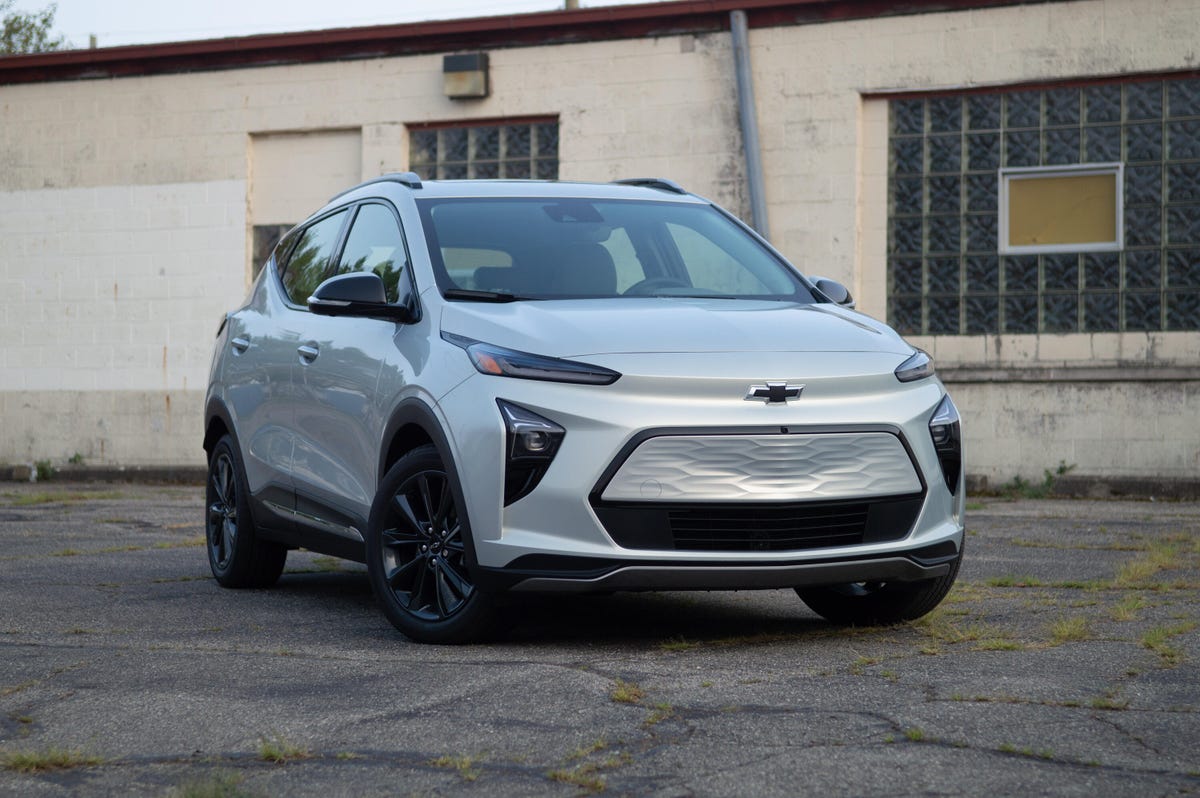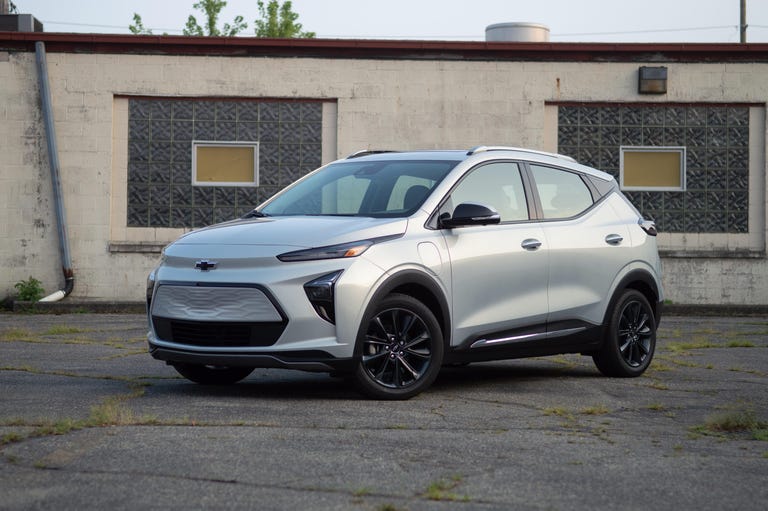 Why You Can Trust CNET
Why You Can Trust CNET 2022 Chevy Bolt EUV review: More space, no drawbacks
GM's Level 2 Super Cruise driver aid is but one reason to stick with the EUV over the EV.
The Bolt EUV looks pretty sharp. Thin headlights (or, in this case, running lights) go a long way on a lot of cars.
The Bolt EUV is a bigger version of a better version of the Chevy Bolt EV. Despite the almost-too-similar taxonomy, the Bolt EUV attempts to distance itself from its sibling by way of adding some interior volume, and the result is swell.
Like
- Improved interior quality
- Peppy powertrain
- Solid cabin tech
Don't like
- Limited cargo capacity
- A little tight with three abreast
If you think the 2022 Chevrolet Bolt EUV looks similar to the Bolt EV (minus the U), U would be correct. The most obvious change between the two is length, where the EUV stretches 6.2 inches longer than the standard Bolt EV. This embiggening adds 3.9 inches of wheelbase and, more importantly, 3.1 inches of rear legroom. The EUV is only 0.2 inches taller and wider than the Bolt EV, though, which means sitting in the middle of the backseat can be a tight affair. Headroom remains ample.
The second-gen Bolt, whether EV or EUV, looks better inside and out. The thin running lights make for more futuristic fasciae, and I dig the texture on the front bumper's "grille." But the real improvement takes place inside, where Chevrolet finally decided to use materials that don't constantly feel cheap. The dash makes use of layers, color and texture, although the gloss black trim throughout can be quite the smudge magnet. The triangle patterns in the Premier's leather seats look nice, and the chairs themselves are sufficiently supportive for longer stretches on the road.
Storage is a mixed bag. The center console's cup holders aren't big enough for large water bottles, but the door pockets help mitigate that. There's a small tray for holding things under the USB ports, but it doubles as the wireless charging pad. I do like that there's enough space under the center armrest for a decently sized purse. The Bolt EUV offers just 16.3 cubic feet of cargo space, enough for a family's groceries or a couple weekender bags, and while it bests competitors like the Hyundai Kona Electric and Nissan Leaf, it's just a little tiny overall. The EPA says the Bolt EV has more cargo space at 16.6 cubic feet, but that's largely due to how the EPA measures cargo volumes -- consider the two functionally identical. There's no frunk, either.
The Bolt EUV's powertrain remains peachy. Despite being positioned as a quasi-crossover of sorts, the EUV is a front-wheel-drive hatchback, sending 200 horsepower and 266 pound-feet of torque to the front axle by way of a single electric motor. That torque value isn't anything to shake a stick at; instantaneous twist means the EUV shoves off in a hurry, although its 215/50R17 Michelin Energy Saver all-season tires are very quick to spin under too much throttle.
The EPA estimates the 2022 Chevy Bolt EUV will run about 247 miles on a single charge, a number I'd say is well within reach. Since driving style factors heavily into these calculations, Chevy provides a high and low estimate for remaining range in the gauge cluster, with a marker that lets me know whether my driving is aiming for efficiency or not. Over a couple hundred miles, I'm showing 3.4 miles per kilowatt-hour used, which translates to about 221 miles from the car's 65-kWh battery pack. The Bolt EUV's built-in brake regeneration is great, with little change in pedal feel between regen and friction, and I enjoy that I can turn on one-foot driving permanently via a switch on the center console, or I can use it on-demand by way of the steering wheel paddle.
Charging the Bolt EUV is a breeze, thanks in part to a 7.2-kilowatt system and a standard dual-level cord that works with both 120-volt Level 1 and 240-volt Level 2 setups (this cable is optional on Bolt EV). Chevy estimates about 7 hours to fill up on a Level 2 charger, which tracks with my experience of hooking up to a public charger and going from 50% to full over the course of a long dinner with friends. As cities continue to flesh out their EV infrastructure, range anxiety should never be an issue here.
The Bolt EUV's longer wheelbase makes for a more comfortable ride, too, smoothing out some of the bouncier antics I find in the shorter Bolt EV. It's never going to be a handling hero -- maybe ask Chevy for an RS variant or something -- but it's not supposed to be. The steering is light as heck, although the optional and largely unnecessary Sport mode does add some weight, so it's clear that the Bolt EUV is for cruising.
When the lights in the steering wheel go green, it's time to cruise -- Super Cruise, that is.
Speaking of cruising, the Bolt EUV carries one optional upgrade you can't get on the Bolt EV. Super Cruise is GM's Level 2 driver aid, combining adaptive cruise control and lane-keeping assist to hold the vehicle in its lane at the pace of traffic on pre-mapped stretches of highway without requiring hands on the wheel. A driver-monitoring camera will make sure my eyes are pointed in the right direction, but once the LEDs in the steering wheel glow green, I'm OK to rest my hands awkwardly in my lap. The system is a little more jittery than I remember in larger vehicles, likely owing to the EUV's tall sides and narrow body, but in most cases it makes smooth inputs and does a pretty good job approximating human driving.
Every EUV gets a 10.2-inch touchscreen on the dashboard running the Chevrolet Infotainment 3 Plus system, which is responsive, easy on the eyes and even easier to navigate. Wireless Apple CarPlay and Android Auto are included, alongside a wireless device charger and a pair of USB ports (one USB-A, one USB-C) per row. A second, 8-inch display takes the place of the gauge cluster, delivering all the pertinent information I need about the car in one of two styles.
On the safety front, all EUV trims come with automatic emergency braking, lane-keeping assist, lane-departure warning and Chevy's Teen Driver suite, which can limit certain features when your progeny takes the car for the night. The Premier beefs that up with rear parking sensors, a rearview camera mirror, a surround-view camera system, blind-spot monitoring and adaptive cruise control. LT buyers can add most of those features on the base trim for $495, which is nice, while Super Cruise is limited to Premier trims and carries a $2,200 price tag.
The Bolt EUV's interior does away with many of the hard, crappy plastics that owners and critics didn't really enjoy on earlier models.
Both trims are aggressively priced, even before federal or local tax incentives are counted. The 2022 Chevy Bolt EUV's LT trim starts at $33,995 including destination, while the Premier trim asks a respectable $38,495. There's a $5,430 Launch Edition Package for the Bolt EUV that adds every option, in addition to unique wheels, a new badge and an illuminated charge port, as well. My tester is more or less fully loaded, and it comes in at $43,495 before incentives.
The Chevy Bolt's competitors used to be few and far between, but times have changed. If you want something a little more down to earth (literally), more traditional hatchbacks like the Kia Niro EV and Nissan Leaf are available, while crossover-friendly folks can find competition from the Hyundai Kona Electric and Volvo XC40 Recharge, although the latter is pretty costly. Both with and without competition factored in, though, the 2022 Chevrolet Bolt EUV is a stellar electric vehicle, with a smooth-cruising nature and plenty of the latest cabin tech.



